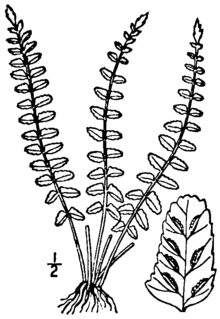Asplenium resiliens
| Blackstem spleenwort | |
|---|---|
 |
|
| Illustration showing fronds and sori of A. resiliens | |
| Scientific classification | |
| Kingdom: | Plantae |
| Division: | Pteridophyta |
| Class: | Polypodiopsida/Pteridopsida (disputed) |
| Order: | Polypodiales |
| Family: | Aspleniaceae |
| Genus: | Asplenium |
| Species: | A. resiliens |
| Binomial name | |
|
Asplenium resiliens Kunze |
|
| Synonyms | |
|
Asplenium ebeneum Ait. var. minus Hook. |
|
Asplenium ebeneum Ait. var. minus Hook.
Asplenium lealii Alston
Chamaefilix resiliens (Kunze) Farw.
Asplenium resiliens, the blackstem spleenwort or little ebony spleenwort, is a species of fern native to the Western Hemisphere, ranging from the southern United States south to Uruguay, including parts of the Caribbean. Found on limestone substrates, it is named for its distinctive purplish-black stipe and rachis. A triploid, it is incapable of sexual reproduction and produces spores apogamously. First described by Martens and Galeotti in 1842 under the previously used name Asplenium parvulum, the species was given its current, valid name by Kunze in 1844. Several similar species are known from the tropics; A. resiliens may have arisen from these species by reticulate evolution, but precise relationships among the group are not yet certain.
It is a small fern with pinnate fronds, growing in erect tufts, with a shiny black stipe and rachis (stem and leaf axis). Sterile and fertile fronds are similar in appearance.
The roots are thin and wiry and do not proliferate to form new plants. The rhizome is short and erect, about 2 millimeters (0.08 in) in diameter. It has variously been described as sometimes branching or unbranched. It bears stiff filamentous, linear, or lance-shaped scales, which are blackish in color and obscurely clathrate (bearing a lattice-like pattern) or entirely black. The scales are 3 to 5 millimeters (0.1 to 0.2 in) long and 0.2 to 0.6 millimeters (0.008 to 0.02 in) wide, with untoothed, often brown, margins and long, drawn-out tips.
...
Wikipedia

